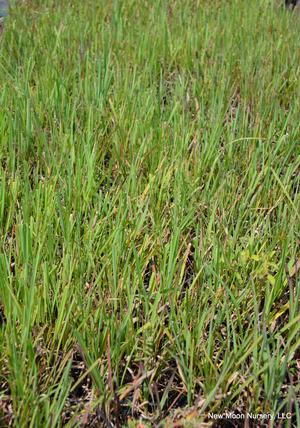New Moon Nurseries

Big bluestem is a warm season grass with fibrous roots, excellent for soil stabilization and erosion control.
Andropogon gerardii
Big bluestem
Native to North America
FIRST IMPRESSIONS: Andropogon gerardii is a clumping perennial grass with a wealth of seasonal interest. In spring, a fresh crop of glaucous stems and graceful arching leaves rise from the earth. By late summer plants have attained a statuesque form clothed in bluish-green foliage and crowned with purplish tassel-like flowers. Leaves turn various shades of earthy red and orange in fall. And finally leaves and seed heads develop an amber winter color. This imposing grass thrives in prairie type settings or in sunny gardens with moist, average or dry soils.
HABITAT & HARDINESS: Andropogon gerardii may be called the “King of the Prairie” because it has the widest distribution of all the prairie grasses. The range extends from Canada into Mexico and in the United States from Montana to Arizona and east from Maine to Florida.
Plants are indigenous to prairies, savannas, glades, roadsides, and fields and are hardy from USDA Zones 3-8.
PLANT DESCRIPTION: Andropogon gerardii is a large upright bunch grass. Plants produce many vertical stems from scaly underground rhizomes. The stems usually have a waxy surface and are blue at the base.
Leaves are linear and gray green to deep bluish green with bases that wrap around the stem. The leaf blades often have purplish highlights when young and usually have some reddish or bronze fall color and coppery winter color.
In late summer as the foliage is reaching its mature height, unique green to reddish three part flowers appear. The arrangement of the three finger-like racemes is reminiscent of a turkey’s foot.
Plants are anchored by an extensive fibrous root system that is said to penetrate the soil to a depth of 10’ or more.
Mature specimens are imposing with a 5-8’ height and 2-3’ spread.
CULTURAL & MAINTENANCE NEEDS: Andropogon gerardii prospers in full sun or light shade in average to moist soil. Plants tolerate clay, alkaline pH, drought, moderate salt levels and seasonal flooding.
This grass should be cut or burned to the ground in late winter. Fertilizer applications, excess shade or abundant water can cause plants to develop weak stems that sprawl or collapse.
LANDSCAPE USES: This grass is a useful Accent or Mass Planting for Wildlife Gardens, Prairies or Meadows. Andropogon gerardii provides Erosion Control, Fall Color, Winter Interest, Interesting Blooms and Unique Seedheads. Plants are appropriate for Cottage Gardens, Low Maintenance Plantings, Water Wise Landscapes, Rain Gardens, Roadsides, Restoration Projects, Stormwater Management and Perennial Borders.
COMPANION & UNDERSTUDY PLANTS: Try pairing with Asclepias tuberosa, Aster novae-angliae, Coreopsis tripteris, Liatris spicata, Rudbeckia hirta or Schizachyrium scoparium.
Sorghastrum nutans has similar height, foliage and cultural needs and can be substituted if needed.
TRIVIA: The Tallgrass Prairies of the Midwestern United States were dominated by four native grasses that are sometimes called "The Four Horsemen of the Prairies". Of these grasses, Andropogon gerardii was the most abundant and tallest. The other “horsemen” are Schizachyrium scoparium, Sorghastrum nutans, and Panicum virgatum.
Hosts caterpillars of several skippers. Seeds are eaten by songbirds and prairie chickens. The dense mass of foliage provides cover and nesting sites for songbirds, secluded spots for butterfly pupation and high protein forage for deer, cattle and other mammals.
Height:
5-7 ftSpread:
2-3 ftUSDA Hardiness Zone:
3-8Bloom Color:
Green, TanAndropogon gerardii Characteristics
Attributes
- Drought Tolerant
- Dried Flower
Exposure
- Full Sun
Deer Resistant
- Deer Resistant
Flowering Months
- August
Foliage Color
- Blue-Green
Grass Season
- Warm Season Grass
Juglans nigra Tolerance (Black Walnut)
- Yes
Salt Tolerance
- Medium
Soil Moisture Preference
- Moist to Dry
Interesting Notes:
For more information on this plant, visit the USDA PLANTS Database:http://plants.usda.gov/java/profile?symbol=ANGE